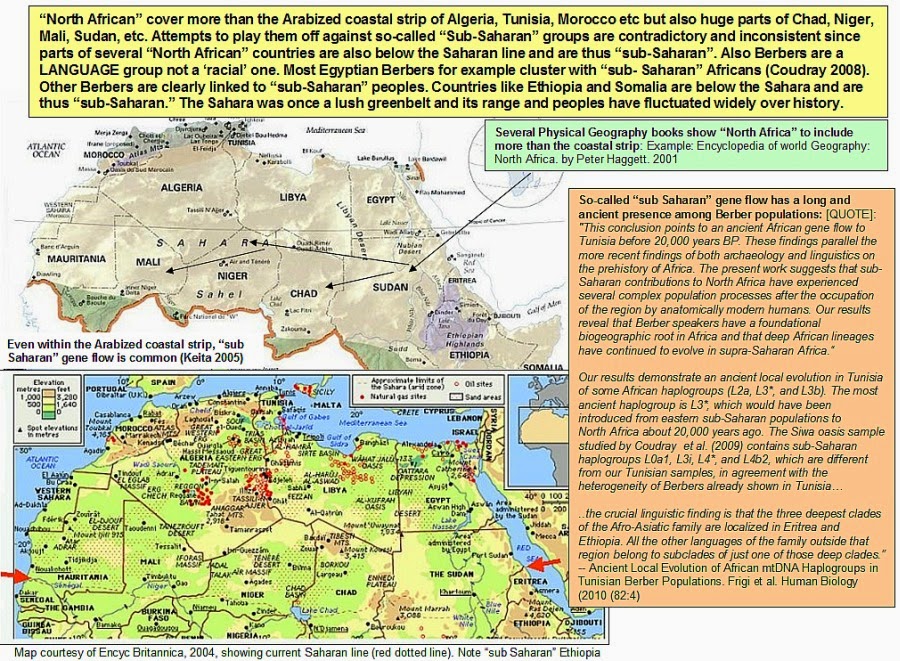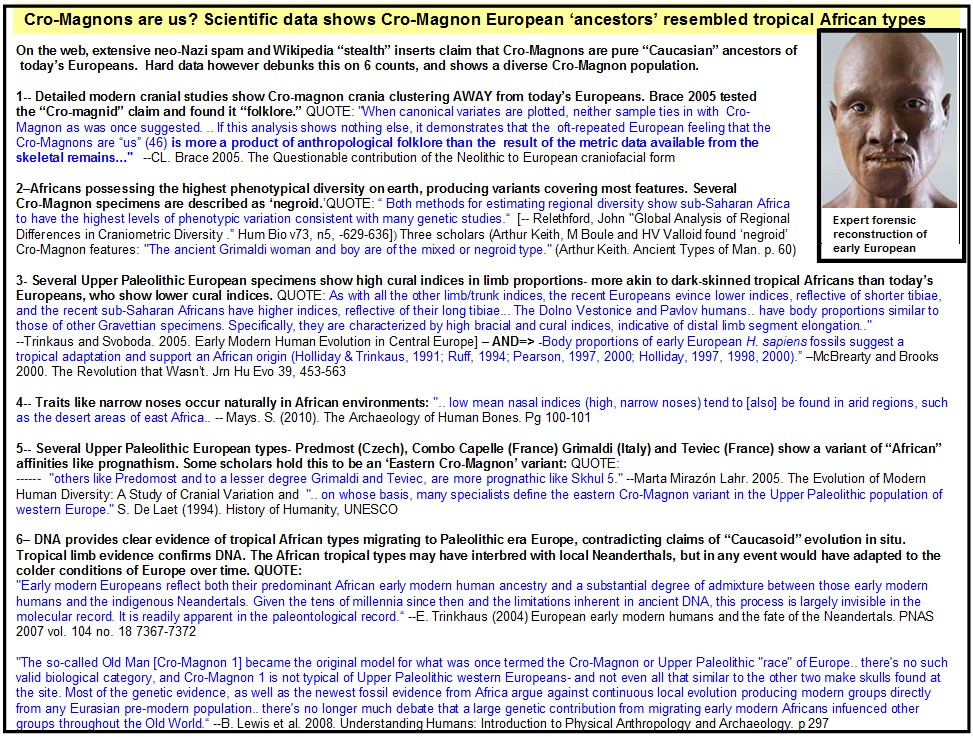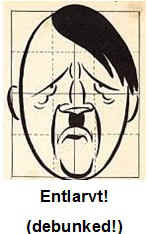|
|
Post by thamm1 on Feb 27, 2016 5:49:35 GMT -5
|
|
|
|
Post by thamm1 on Feb 27, 2016 5:50:59 GMT -5
|
|
|
|
Post by thamm1 on Feb 27, 2016 5:54:00 GMT -5
Black people among the Tuaregs are decended from slaves. .Tuaregs held slaves and they did mix with them for a part.
|
|
|
|
Post by thamm1 on Feb 27, 2016 6:08:18 GMT -5
 Here is a reconstruction of the Homo-Sapiens Mechta-Afalou from North Africa. His 25,000 year old skull was discovered on the site of Afalou in Algeria in 1967. Facial reconstitution Mechta-Afalou from Algeria was carried out by Elisabeth Daynes, in collaboration with Jean Noel Vignal, after the work of Djillali Hadjouis. The dates for the Afalou predate by tens of thousands of years the proposed date for the arrival of the proto-Berbers. |
|
|
|
Post by thamm1 on Feb 27, 2016 14:55:44 GMT -5
This proves it right here. ^^^ White north Africans are indigenous to that area and have no relation to black Sub-Saharan people. They, negroids, came as slaves later.
|
|
|
|
Post by thamm1 on Feb 28, 2016 5:11:52 GMT -5
You have been debunked.
|
|
|
|
Post by anansi on Feb 28, 2016 19:54:22 GMT -5
And oh Btw. in case you forgot ...There were no White ppl 25,000 yrs ago but the good drs Elisabeth Daynes, in collaboration with Jean Noel Vignal, didn't know that back in 1967 actually no one did, so much for relaying on outdated data. How Europeans evolved white skinYeah so here I am and there you are totally debunked. now you look over these post and actually put some thought in your response before kliking the create button . have a nice day.  |
|
|
|
Post by zarahan on Feb 28, 2016 22:25:40 GMT -5
Excellent roundup Anansi. These people think their nonsense is going to get a free pass but it won;t. And the info you have posted above will be freshly reloaded into the web where conscious black cats can pull it up and use it to destroy bogus propaganda bout "late-coming" or "missing black people" in North Africa. lmao.. And "North Africa" includes a wide zone from Mali, to Niger, to Chad to Sudan, not simply the coastal strip. Any argument based on the coast as "representative" of North Africa, right away falls flat.  But the clincher about what you say Anansi is that there were no "white" people 25kya, so how could black folk be "missing"? I am falling over with laughter. Great point.  ^^"missing" black folk... |
|
|
|
Post by zarahan on Feb 28, 2016 22:26:26 GMT -5
Thammi says: Facial reconstitution Mechta-Afalou from Algeria was carried out by Elisabeth Daynes, in collaboration with Jean Noel Vignal, after the work of Djillali Hadjouis. Unimpressive. First of all, African features are variable. Cro-Magnons, as several credible SCHOLARS show, had several variants resembling Africans. Cro-magnons have variable features,[/b] well within African diversity as well with some scholars seeing an Eastern variant and a Western variant. Some cro-mags may have looked different in cold climates compared to those in warmer locales. The point is that they are variable and African looks are well represented among Cro-magnons. In any event Brace 2005 debunks the European claim that "Cro-magnon;s are us." You fail here.  Thammi also said: White north Africans are indigenous to that area and have no relation to black Sub-Saharan people. They, negroids, came as slaves later. hA HA AHAHAHAH AHA AH.. Comedy doesnt get any better than this drivel. Let's go with it for a moment. Unfortunately for the Faker credible scholars show that "negroid" types have been long in place in north africa, and the "afalou" zone. In fact, credible archaelogical data notes several resemblance of cultural artefacts to the industries of west and central Africa. The Aterian shows some similarities with "sub Saharan" cultures, indicating its emergence is part of an indigenous mosaic of African cultures and not some import from elsewhere: QUOTE: "Some researchers such as Debenath (1994) argue that the Aterian extends along the coast if Algeria and Morocco with sites decreasing in density farther inland. But Kleindienst suggests that this might be a product of the fact that most research has been done in the Maghreb. For her, there could be a link between the Aterian and the Lupemban industry of central and West Africa, where bifaces and occasional tanged pieces are present in otherwise Middle Stone Age contexts (Kleindienst 2001:6.9 Hawkins and Kleindienst 2002)."--P. Willoughby. 2006. The evolution of modern humans in Africa and "The Aterian appeares to be a facies of the North African Middle Paleolithic and is characterized by tanged points and oter tools; bifacial points are known from some Aterian sites, notably in the eastern and southern areas, such as Bir Tarfawi in Egypt and Adrar Bous in Niger." -- Encyclopedia of human evolution and prehistory. 1999. Eric Delson, Ian Tattersall, John A. Van Couvering. AND "North Africa is quickly emerging as one of the more important regions yielding information on the origins of modern Homo sapiens. Associated with significant fossil hominin remains are two stone tool industries, the Aterian and Mousterian, which have been differentiated, respectively, primarily on the basis of the presence and absence of tanged, or stemmed, stone tools. Largely because of historical reasons, these two industries have been attributed to the western Eurasian Middle Paleolithic rather than the African Middle Stone Age. In this paper, drawing on our recent excavation of Contrebandiers Cave and other published data, we show that, aside from the presence or absence of tanged pieces, there are no other distinctions between these two industries in terms of either lithic attributes or chronology. Together, these results demonstrate that these two ‘industries’ are instead variants of the same entity. Moreover, several additional characteristics of these assemblages, such as distinctive stone implements and the manufacture and use of bone tools and possible shell ornaments, suggest a closer affinity to other Late Pleistocene African Middle Stone Age industries rather than to the Middle Paleolithic of western Eurasia." -On the industrial attributions of the Aterian and Mousterian of the Maghreb, Harold L. Dibble et al. Journal of Human Evolution, 2013 Elsevier. and "The African Epipaleolithic (Mesolithic) sample, comprising material from Nubia (Jebel Sahaba-sites 117 and 8905 and Wadi Haifa) and the Magreb (Afalou-bou-Rhummel and Taforalt), is quite homogenous both morphologically and metrically."American Journal of Physical Anthropology. Volume 96. Issue 3, 1995 "The bones are those of a man of late middle age, tall (1.70 metres or about 5 ft. 7 in.), distinctly Homo sapiens but not of 'Mediterranean' type. From the shape of the nasal and long bones it is clear that Asselar Man was some sort of negroid. The skull is dolichocephalic and has a high vault, whereas the rather short face is broad. There is marked alveolar-dental prognathism, ansd the mental eminence is well marked. The teeth are large and the third molar well developed. There was avulsion (i.e. 'knocking out') of the upper incisors, an ancient practice. The nearest living type to Asselar Man would seen to be that of the southern African Bantu-speaking peoples."  STRIKE 1 - ANCIENT LITHIC DATA But let's not stop at the above. The Faker says there were no black people in North africa until the historic slave era. But unfortunately for him, ancient African migration data from the south shoot down his bogus rubbish. QUOTE: ARCHAELOGICAL DATA SHOWS LONG-STANDING ANCIENT MIGRATION BETWEN NORTH AND SUB-SAHARAN AFRICA qUPTE: "Whilst backed bladelet production is broadly shared across the different regions of North
and East Africa, there was also a level of regional cultural diversity during this period,
possibly mirroring a diversification of populations. The Sahara Desert expanded considerably
during the LGM, perhaps concentrating human groups along the North African coastal belt and the Nile
Valley. Climatic conditions improved in North Africa ~15 KYA, marking the beginning of a
dramatic arid-to-humid transition [25]. This increase in humidity may have opened up
ecological corridors, connecting North and Sub-Saharan Africa and allowing population
dispersals between the two regions. An additional arid-humid transition occurred at 11.5–11
KYA [25]; this period coincides with a widespread change in the archaeological record that
marks the beginning of Capsian lithic technologies. The Capsian is argued to have developed
in situ in North Africa, marking a continuity from the Iberomaurusian and Oranian into the
Capsian [21,24,26]." -- Pennarun, et al (2012) Divorcing the Late Upper Palaeolithic demographic histories of mtDNA haplogroups M1 and U6 in Africa. BMC Evolutionary Biology 2012, 12:234 OUT OF AFRICA MIGRATION DATA SHOWS MOVEMENT FROM THE SOUTH INTO NORTH AFRICA ALMOST 80,000 YEARS
AGO, NOT ANY "RECENT" APPEARANCE BY BLACK PEOPLE. QUOTE: This paper focuses on the events that took place in North Africa. In this region, anatomically modern humans were not always successful once they departed from Africa and moved towards the temperate, and dry, latitudes of the eastern Mediterranean basin in the Levant. Two distinct movements have been recognised within the Out-of-Africa 2 model, one occurring between c. 130 and 80 ka, the other taking place after 50 ka. The two phenomena were separated by an abrupt climatic transition that affected the south-western Mediterranean basin during the transition from MIS 5a to MIS 4, around 74 ka. As these two events exhibit very distinct features and are divided by a long time span, it seems reasonable to refer to the first event as “Out of Africa 2a” and to the second one as “Out of Africa 2b”. "----Garza et al 2012. Late Pleistocene lifeways, an African perspective: Successes and failures of human dispersals from North Africa selected presentations, PAA-Safa 2010 Volume 270, 23 August 2012, Pages 119-128  STRIKE 2 - ANCIENT MIGRATION DATA DNA studies debunk this bogus claim too. Ancient Tunisia right next to Algeria also shows
long, ancient African presence, contradicting bogus claims of "missing" black people in
North Africa QUOTE: NORTH AFRICA HAS A LONG HISTORY OF ANCIENT MIGRATION FROM SUB-SAHARAN AFRICA WELL BEFORE ANY "SLAVERY" AS DNA SHOWS"We have analysed a linked microsatellite/Alu polymorphism at the CD4 locus (CD4/Alu) in 666 chromosomes from samples of the Iberian Peninsula, Northwest Africa, and West sub-Saharan Africa. The Iberian Peninsula differs from other European populations by its higher levels of haplotype diversity (0.75), and weaker association between the microsatellite allele 90 and Alu(-) chromosomes. These results are explainable by a substantial gene flow from Northwest Africa. Significant geographic clines for the five major haplotypes suggest a south to north migration from sub-Saharan Africa into Northwest Africa. In spite of this, the consistent presence of haplotype 110(-) in this area is congruent with an ancient and autochthonous human presence in Northwest Africa. --FLORES 2010. Northwest African distribution of the CD4/Alu microsatellite haplotypes. and "Our objective is to highlight the age of sub-Saharan gene flows in North Africa and particularly in Tunisia. Therefore we analyzed in a broad phylogeographic context sub-Saharan mtDNA haplogroups of Tunisian Berber populations considered representative of ancient settlement. More than 2,000 sequences were collected from the literature, and networks were constructed. The results show that the most ancient haplogroup is L3*, which would have been introduced to North Africa from eastern sub-Saharan populations around 20,000 years ago. Our results also point to a less ancient western sub-Saharan gene flow to Tunisia, including haplogroups L2a and L3b. This conclusion points to an ancient African gene flow to Tunisia before 20,000 years BP. These findings parallel the more recent findings of both archaeology and linguistics on the prehistory of Africa. The present work suggests that sub-Saharan contributions to North Africa have experienced several complex population processes after the occupation of the region by anatomically modern humans. Our results reveal that Berber speakers have a foundational biogeographic root in Africa and that deep African lineages have continued to evolve in supra-Saharan Africa."--Frigi et al. Human Biology (August 2010 (82:4) and And SOY Keita weighs in, debunking Euro double standards that seek to "whitewash" black people
out of North Africa  STRIKE 3 - ANCIENT DNA DATA That's 4strikes on 4 lines of evidence- Variable Cro-magnon features, ancient lithic industries, ancient migrations and ancient DNA.  |
|
|
|
Post by thamm1 on Mar 1, 2016 7:24:16 GMT -5
You don't seem to know much about genetics or history. NATIVE ORIGIN (original indigenous) Berbers were / are (what remains) EURASIAN and E subclade M-81. This subclade pertains primarily to NW Africa, although it is found as far north as Scandinavia. " Berbers are genetically white. Reconstruction of the Homo-Sapiens Mechta-Afalou from North Africa Attachment DeletedThese prehistoric North Africans are described as mostly similar to other Mediterranean Caucasian populations, with a lesser similarity to Nubians from the Wadi Halfa area Reconstruction of the Homo-Sapiens Mechta-Afalou from North Africa  |
|
|
|
Post by thamm1 on Mar 1, 2016 7:27:53 GMT -5
Modern DNA-research does already give a pretty clear picture. Simply observing the existing phenotypes on photographs or in the living shows what racial admixtures have taken place or are in the process presently. But, in my opinion, one has to start at the beginning: African origin of mankind refers to geographic, not to racial origin. Black African humanity has never changed colour or skeletal structures under a non-African sky. The same goes for rosy-white skin. Neither of the two will change other than through racial mixture. I tend to believe that all colours and skeletal structures go back to the beginning of mankind and have emerged out of a big genetic pool. Mutations, combination, and re-combination played their role. Afro-centric theories, Out-of-Africa, African Eve can easily be used to serve agendas that have nothing to do with Physical Anthropology.
White skin for instance exists under the fur of all types of animals in any climatic zone of the world. As far as the human side goes, changes happen by mixture, exemplified by Ainu, Berbers, and recently some British, or French people, to name only a few. Pure white skin has been proven to exist in China, Japan, North Africa, Polynesia, and Europe. Thanks to DNA we now know a lot better who is who.
|
|
|
|
Post by thamm1 on Mar 1, 2016 7:28:41 GMT -5
Berber and Arab DNA in Europe from the Moorish occupation. There are only Arab and Berber Y chromosomes found.
We have analyzed Y-chromosome diversity in the western Mediterranean area, examining p49a,f TaqI haplotype V and subhaplotypes Vb (Berber) and Va (Arab). A total of 2,196 unrelated DNA samples, belonging to 22 populations from North Africa and the southern Mediterranean coast of occidental Europe, have been typed. Subhaplotype Vb, predominant in a Berber population of Morocco (63.5%), was also found at high frequencies in southern Portugal (35.9%) and Andalusia (25.4%)
Haplotype V (E3b1b) (A2,C0,D0,F1,I1) is the most frequent haplotype in North Africa (Lucotte et al. 2000), with a particularly high frequency (55%) in the populations with a relative predominance of Berber origin. Our previous study on the subject examined the relative frequencies of haplotype V in four Iberian populations compared with a Berber population living in North Africa (Lucotte et al. 2001). The highest frequency of haplotype V (68.9%) was observed in Berbers from Morocco, and the geographic distribution of haplotype V revealed a gradient of decreasing frequencies with latitude in Iberia (40.8% in Andalusia, 36.2% in Portugal, 12.1% in Catalonia, and 11.3% in the Basque Country) (Lucotte et al. 2001); such a cline of decreasing haplotype V frequencies from the south to the north in Iberia clearly established a gene flow from North Africa toward Iberia.
|
|
|
|
Post by thamm1 on Mar 1, 2016 7:33:03 GMT -5
|
|
|
|
Post by thamm1 on Mar 1, 2016 7:33:15 GMT -5
The indigenous North African ancestry may have been more common in Berber populations and appears most closely related to populations outside of Africa, but divergence between Maghrebi peoples and Near Eastern/Europeans likely precedes the Holocene [>12,000 ya]. We also find significant signatures of sub-Saharan African ancestry that vary substantially among populations. These sub-Saharan ancestries appear to be a recent introduction into North African populations, dating to about 1,200 years ago in southern Morocco and about 750 years ago into Egypt, possibly reflecting the patterns of the trans-Saharan slave trade that occurred during this period.
|
|
|
|
Post by zarahan on Mar 1, 2016 18:39:02 GMT -5
You have already failed and your tactic of making a large number of "mini" posts in the hopes "volume" will help your case, also falls flat. Same with your "shifting goalpost" tactic of conveniently "forgetting" the claims you have already made. Let's take it from the top. 1. You claimed the imhabitants of North Africa were white. But the time frame of skin color mutations as detailed by Anansi re the works of Jablonski 2012, or Orlade 2014 show that there were no white people around during that time period. Your "whiteness theory" thus fails on the get go. 2. You claimed that there were no black people in North Africa until the historic slave period. But here you also trip for on 3 counts, as detailed above, cultural artifacts, African migration data, and DNA analysis show that the African presence has been in place in North Africa for tens of thousands of years, debunking your drivel comprehensively. 2a) Indeed, even if this WASN'T the case above, "North Africa" includes more than merely the coastal strip near the Mediterranean, it extends into huge parts of Mali, Mauritania, Chad and the Sudan. ANy claim about "North Africa" using samples near the coast is questionable from the start. 2b) The full range of "North Africa" incorporates Mali, which shows plenty of "negro" types as well via cranio-skeletal data, and cuktura artefacts fitting the North African "Mechta" pattern. 2c) But even this isn't needed. Africans are the most phenotypically diverse. So called "mechta" features are nothing special- they fall within the range of indigenous African diversity. 3) You try a "Berber connection" to avoid the gaping holes in your case, but as Frigi and Keita show above, so called "negro" elements are well represented among the Berbers going back to very ancient times. They did not suddenly appear via the "slave" era.  4) You try to use Henn's paper on possible back-migration to Africa in support- quote: " We also find significant signatures of sub-Saharan African ancestry that vary substantially among populations. These sub-Saharan ancestries appear to be a recent introduction into North African populations, dating to about 1,200 years ago in southern Morocco"But this does not at all support your claims. For one thing, no one denies gene flow from outside into Africa in various eras. But if there were "back-migration" then ORIGINALLY, there were the dreaded "Negroids" ALREady in place to migrate out. There could be no "back migration" unless the negroes had left in the first place. This debunks your claim that there were no black people in Africa until recently due to "slavery." Second, Henn herself shows that the "negroids" were in place as revealed by their cultural artefacts. Quote: "But the indigenous development of ceramics in Saharan Africa by 9,000 ya is also suggestive of an incipient form of agriculture or pastoralism, prior to any demic diffusion from the Near East..." In other words, your own "supporting" reference, shows the negroes already on the ground PRIOR to any "Near East" arrival. And then, your own "supporting" reference shows that the author is only talking about recent history in a limited slice of coastal North Africa- Morocco. quote: " We estimate that a migration of western African origin into Morocco began about 40 generations ago (approximately 1,200 ya); " But this is simply recent history and does not cover the vast territory that is north Africa, and does not even deal with the "Mechta" types. In fact Henn mentions no "Mechta" at all. You have shot yourself in the foot with your own "supporting" reference. In any event any "backflow" to Africa would be like people who already looked like Africans.  5) Your "Mechta" picture is less than advertised. ELiabeth Daynes' reconstruction is actually an estimate of a EUROPEAN Cro-Magnon variant, not a direct take on Mechta fossils. The picture you keep showing is not based directly on the Mechta. Mechta features also incorporate "negroid" elements as the North African data already posted indicates. ANy reconstruction showing what looks like a white guy in skins is not based on the actual data on the ground re the Mechta-afalou. In fact in French, there is controversy as to the so-called "Mechtoids" with some French authorities holding that interbreeding with African stocks already in place makes for variable "Mechtoid" features. THis in any event shows that the Africans would be ALREADY IN PLACE before any claimed "Mechtoids" even show up. You hope to escape scrutiny by relying on a French sources not translated into English, but even the barest translation already shows your clain to be shaky, and that's your own "supporting" reference. Pour les autres, comme Djillali Hadjouis (2003, com. pers.), il y aurait impossibilité anatomique de passer du type Mechta-Afalou au type Protoméditerranéen. Les caractères mechtoïdes qui subsistent proviendraient de métissage. Dans les .TransL For others, like Djillali Hadjouis (2003, pers. Comm.), There would be anatomically impossible to spend Mechta- Afalou Protoméditerranéen kind in kind. The remaining characters mechtoïdes come from interbreeding.  ^^ Your attempt to pass off a European Cro-magnon variant as the actual Mechta fossil recreation fails.. Mechta features ALSO INCLUDE "negro" elements across the North African zone which clearly have not been addressed in the selective whitewashed model above.. 5) Finally, you add yet ANOTHER hole to you case by claiming that: Black African humanity has never changed colour or skeletal structures under a non-African sky. The same goes for rosy-white skin. Neither of the two will change other than through racial mixture.[/b] But this is laughable. African sky covers one of the most diverse places on earth- from burning desert, to cold high altitude mountains, to cool cloud forest, to sweltering rainforest. African skin color has changed due to cooler climates for example, and African noses likewise have modified due to climatic factors, like deserts or high altitudes, which tend to promote narrower noses without needing any "incoming Caucasoids" to explain why. Just nose shape adaptations blow your notion out of the water.  |
|